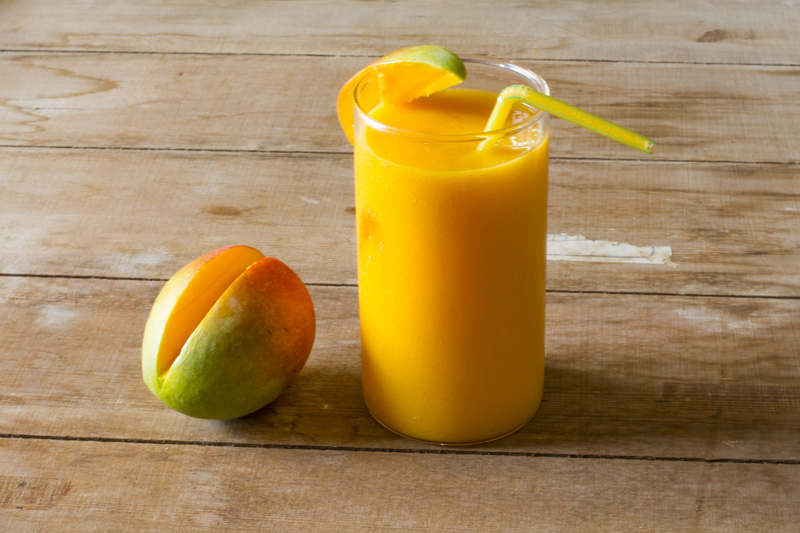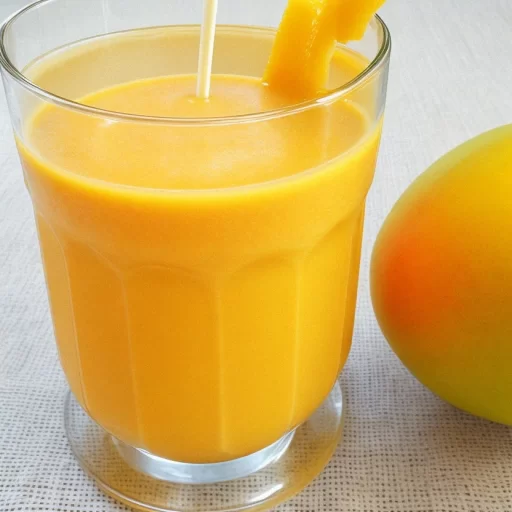Introduction:
How To Prepare Mango Juice is one of the most favorite Juice for everyone . Known as the “king of fruits,” have vitamins, minerals, and antioxidants, making mango juice not only delicious but also beneficial for your health. Whether you’re looking to cool down on a hot day or add a tropical twist to your meals, mango juice is the perfect choice. In this article, we’ll guide you through the process of preparing mango juice at home, ensuring that every step enhances the flavor and freshness of this delightful drink.

Ingredients You’ll Need:
Fresh Ripe Mangoes: 3-4 medium-sized mangoes (preferably Alphonso, Haden, or Ataulfo for their sweetness and flavor)
Water: 1-2 cups, depending on the desired consistency
Sugar or Honey: 1-2 tablespoons (optional, depending on the sweetness of the mangoes)
Lemon or Lime Juice: 1 tablespoon (optional, for a tangy twist)
Ice Cubes: As needed for serving
Step-by-Step Guide to Preparing Mango Juice
1.Select and Prepare the Mangoes:
The ripeness of the mangoes is crucial as it directly impacts the sweetness and flavor of the juice.
Peel the mangoes using a knife or vegetable peeler. Start from the top and work your way down, ensuring that the peel is entirely removed.
Slice the mangoes along the sides of the pit. The flesh should easily come away from the stone. Cut the flesh into small chunks for easy blending.
2.Blend the Mangoes:
Place the mango chunks in a blender. Add some mineral water to blend this properly.
Blend the mangoes until you achieve a smooth, lump-free puree. Need some time depending on your blender power.
Taste the puree to check its sweetness. If the mangoes are not sweet enough, you can add sugar or honey at this stage. Blend again to mix well.
3.Adjust the Consistency:
If the juice is too thick, gradually add more water until you reach your desired consistency. For a richer, creamier juice, you can substitute water with coconut water or milk.
For a tangy flavor, add a tablespoon of lemon or lime juice. This not only enhances the taste but also helps preserve the vibrant color of the juice.
4.Strain (Optional):
If you prefer a smoother juice without any pulp or fibers, you can strain the juice using a fine mesh sieve or cheesecloth. Pour the juice through the strainer into a jug, pressing down with a spoon to extract all the liquid.
5.Chill and Serve:
Refrigerate the juice for about 30 minutes before serving, or pour it over ice cubes for an immediate refreshment.
Serve the mango juice in a chilled glass, garnished with a slice of mango, a sprig of mint, or a wedge of lime for an extra touch of elegance.
Variations and Tips:
Mango Smoothie: For a thicker, more filling version, blend the mango with yogurt or a scoop of vanilla ice cream.
Spicy Mango Juice: Add a pinch of chili powder or ground ginger for a spicy kick that contrasts beautifully with the sweetness of the mango.
Mango Mocktail: Mix the mango juice with sparkling water or soda and garnish with a twist of lime for a fizzy treat.
Health Benefits of Mango Juice:
Mango juice is not only delicious but also packed with nutrients. There has in vitamin C, which boosts your immune system & your skin. The juice also provides a good amount of vitamin A, which is essential for eye health. Mangoes are also a great source of dietary fiber, which aids digestion and helps maintain a healthy gut.
Conclusion:
Making mango juice at home is a simple and rewarding process that allows you to enjoy the pure, unadulterated flavor of this beloved tropical fruit. By following these steps, you can create a refreshing beverage that can be enjoyed on its own or as a base for various other drinks and desserts. So the next time you come across ripe mangoes, don’t hesitate to turn them into a glass of golden goodness. Your taste buds will thank you!
Can you juice mangoes with the skin on?
Mangoes are a beloved tropical fruit, known for their sweet, juicy flesh and vibrant color. When it comes to making mango juice, most people instinctively peel the mangoes, discarding the skin before juicing. However, some wonder whether it’s possible, or even beneficial, to juice mangoes with the skin on. In this article, we’ll explore the potential advantages and disadvantages of juicing mangoes with their skin, and provide insights on whether this approach is right for you.
Is It Safe to Juice Mangoes with the Skin On?
Yes, it is generally safe to juice mangoes with the skin on, but there are a few important considerations. Mango skin is edible and contains a variety of nutrients, including fiber, antioxidants, and vitamins. However, the skin can also be tough, slightly bitter, and may contain trace amounts of natural compounds that could cause allergic reactions in some individuals. Before deciding to juice mangoes with the skin on, it’s essential to weigh these factors.
Potential Benefits of Juicing Mangoes with the Skin On
Increased Nutrient Intake:
Mango skin is packed with nutrients that you might miss out on if you peel the fruit. It contains a higher concentration of fiber, which aids digestion and helps regulate blood sugar levels. Additionally, the skin has a variety of antioxidants, such as polyphenols and carotenoids, that help fight free radicals in the body.
Enhanced Flavor Profile:
The skin of a mango can add a unique depth of flavor to the juice. While it may introduce a slight bitterness, it also provides a more complex taste that some people find appealing, especially when combined with other ingredients like citrus or ginger.
Less Waste:
By juicing mangoes with the skin on, you’re reducing food waste. The skin, which would otherwise be discarded, is put to good use, maximizing the fruit’s potential.
Time-Saving:
Skipping the peeling process can save time, especially if you’re juicing a large batch of mangoes. This convenience can be a significant advantage for those who are in a hurry or looking to simplify their juicing routine.
Texture and Consistency:
Mango skin is tough and fibrous, which can result in a juice with a grittier texture. Even with powerful blenders or juicers, the skin might not break down completely, leaving small pieces in the juice that some may find unpleasant.
Potential Allergic Reactions:
Mango skin contains urushiol, a compound also found in poison ivy and poison oak. While the concentration in mango skin is much lower, it can still cause allergic reactions in sensitive individuals, leading to skin irritation or a rash. If you have a history of such allergies, it’s best to avoid juicing mangoes with the skin on.
Bitter Taste:
The skin of the mango has a slightly bitter taste, which might not be to everyone’s liking. If you’re used to the sweet, luscious flavor of mango juice, the addition of the skin could alter the taste in a way that you may not enjoy.
Pesticide Residue:
If the mangoes are not organic, the skin may contain pesticide residues, even after washing. While thorough washing can remove most of the surface chemicals, some may still remain, potentially affecting the safety and taste of your juice.
Tips for Juicing Mangoes with the Skin On
Choose Organic Mangoes: Opt for organic mangoes if you plan to juice them with the skin on. This reduces the risk of ingesting pesticide residues and ensures a more natural juice.
Wash Thoroughly: Even with organic mangoes, it’s crucial to wash the skin thoroughly under running water. You can use a produce brush to scrub the surface and remove any dirt or residues.
Blend with Other Fruits: To balance the bitterness of the mango skin, consider blending the juice with other sweet fruits like oranges, pineapples, or apples. This can help mask the bitter notes while enhancing the overall flavor.
Strain the Juice: If the texture of the skin is an issue, you can strain the juice through a fine mesh sieve or cheesecloth to remove any fibrous bits, resulting in a smoother drink.
Conclusion:
How To Prepare Mango Juice with the skin on is a personal choice that depends on your taste preferences, dietary needs, and any potential allergies. While the skin adds extra nutrients and a unique flavor, it also introduces a tougher texture and a slight bitterness that may not appeal to everyone. If you’re adventurous and enjoy experimenting with flavors, juicing mangoes with the skin on can be a fun way to experience the fruit in a new light. However, if you prefer a smooth, sweet juice, it might be best to stick to the traditional method of peeling the mangoes first. Whatever you decide, the key is to enjoy the process and savor the delicious results.

How to make mango juice easy?
Mango juice is a delightful way to enjoy the sweet, tropical flavor of mangoes. Whether you’re a seasoned chef or just someone looking to whip up a quick and refreshing drink, making mango juice at home is easy and satisfying. In this guide, we’ll show you how to make mango juice in the simplest way possible, ensuring that you can enjoy this fruity beverage with minimal effort.
Ingredients You’ll Need:
Ripe Mangoes: 2-3 medium-sized mangoes (any variety will work, but Ataulfo, Alphonso, or Kent are particularly good)
Water: 1-2 cups (adjust to your preferred consistency)
Sugar or Honey: 1-2 tablespoons (optional, depending on the sweetness of the mangoes)
Ice Cubes: Optional, for serving
Step-by-Step Guide to Easy Mango Juice
1.Choose and Prepare the Mangoes:
Start with ripe mangoes. Ripe mangoes are sweet, juicy, and easy to work with. They should give slightly when pressed and have a fragrant aroma.
Wash the mangoes thoroughly under running water. This ensures that any dirt or residues on the skin are removed, especially if you plan to juice the mangoes with the skin on.
Peel the mangoes using a knife or vegetable peeler. If you prefer a quicker method, slice off the “cheeks” of the mango (the two fleshy sides) and scoop out the flesh with a spoon.
Cut the mango flesh into chunks for easy blending.
2.Blend the Mangoes:
Place the mango chunks in a blender. Add a cup of water to help the blending process. If you prefer thicker juice, use less water; for a thinner juice, add more.
Blend the mangoes until smooth. This should take about 30-60 seconds, depending on the power of your blender.
Taste the juice. If the mangoes are not sweet enough, add sugar or honey to taste and blend again briefly to mix.
3.Adjust and Serve:
If the juice is too thick, use some water & blend it again. For those who prefer a richer flavor, you can substitute water with coconut water or even a splash of orange juice.
Pour the juice into a jug or directly into glasses.
If you like your juice chilled, add ice cubes to the glasses before pouring. You can also refrigerate the juice for about 30 minutes before serving.
4.Garnish and Enjoy:
For an extra touch, garnish your mango juice with a slice of mango or a sprig of mint.
Serve properly and enjoy the taste of homemade mango juice.
Tips for Making the Process Even Easier
Use Frozen Mango Chunks: If you’re in a hurry, you can use pre-cut frozen mango chunks instead of fresh mangoes. This saves time on peeling and cutting, and also makes the juice naturally cold.
Skip the Straining: If you don’t mind a bit of pulp in your juice, you can skip the straining process entirely. This makes the preparation even faster and retains more fiber.
No Blender? No Problem! If you don’t have a blender, you can use a food processor or even mash the mango flesh by hand with a fork or potato masher, then mix with water and sugar.
Make in Batches: If you often crave mango juice, consider making a large batch and storing it in the refrigerator. Fresh mango juice can last up to 2-3 days in a sealed container.
Conclusion:
How To Prepare Mango Juice at home doesn’t have to be a complicated process. With just a few ingredients and a blender, you can create a delicious and refreshing drink in minutes. Whether you enjoy it as a quick breakfast, a midday snack, or a refreshing accompaniment to a meal, homemade mango juice is always a treat. So, the next time you’re craving something tropical and sweet, try making mango juice the easy way—you won’t be disappointed!
How long can fresh mango juice last?
Mango juice is a delicious and refreshing beverage that’s perfect for hot days or as a complement to your meals. However, once you’ve made a fresh batch of this sweet nectar, you might wonder how long it can last before it starts to lose its freshness or spoil. Proper storage is key to extending the shelf life of your homemade mango juice while preserving its flavor and nutritional value. In this article, we’ll explore how long fresh mango juice can last, the best ways to store it, and signs that it’s time to toss it out.
How Long Does Fresh Mango Juice Last?
Fresh mango juice, like most fruit juices, is best enjoyed immediately after preparation to savor its peak flavor and nutritional benefits. However, if stored properly, it can last for a few days. Here’s a general guideline:
Refrigerated Mango Juice: When stored in the refrigerator at 4°C (39°F) or lower, fresh mango juice can last 2 to 3 days. After this period, the juice may begin to lose its fresh taste, and the texture might change as the juice starts to separate.
Room Temperature: If left at room temperature, fresh mango juice should be consumed within 2 to 3 hours. Beyond that, the juice is likely to spoil, especially in warm climates, as it provides an ideal environment for bacteria to grow.
Best Practices for Storing Fresh Mango Juice
To maximize the freshness and longevity of your mango juice, follow these storage tips:
Use an Airtight Container:
Store the juice in a clean, airtight container to prevent oxidation, which can cause the juice to lose its vibrant color and fresh taste. Glass containers are preferable as they don’t absorb odors or flavors, but BPA-free plastic containers can also work.
Refrigerate Promptly:
After preparing the juice, refrigerate it as soon as possible. The quicker you chill the juice, the longer it will maintain its freshness.
Avoid Contamination:
Ensure that all utensils, blenders, and containers used in the juice-making process are thoroughly cleaned and sanitized. Any bacteria introduced during preparation can shorten the shelf life of the juice.
Keep it Cold:
If you’re serving the juice over a period of a few hours, keep it in a pitcher over ice or return it to the fridge between servings. This helps maintain a consistent temperature and prevents the juice from warming up, which could speed up spoilage.
Freeze for Longer Storage:
If you’ve made more juice than you can consume within a couple of days, consider freezing it. Fresh mango juice can be frozen for up to 6 months without significant loss of flavor or quality. Pour the juice into freezer-safe containers, leaving some space at the top to allow for expansion as it freezes. When you’re ready to enjoy it, thaw the juice in the refrigerator overnight. Make whole wheat sandwich bread with flour, water, honey, yeast, and oil. Bake soft, healthy loaves perfect for sandwiches.
Signs That Mango Juice Has Gone Bad
Even with careful storage, fresh mango juice will eventually spoil. Here are some signs to watch out for:
Change in Smell:
Fresh mango juice should have a sweet, fruity aroma. If the juice develops a sour or off-putting smell, it’s likely fermented and should be discarded.
Altered Taste:
If the juice tastes sour, bitter, or off, it’s a sign that it’s no longer safe to drink. The flavor change is often accompanied by a noticeable change in smell as well.
Separation and Texture:
While some separation is natural in fresh juice, excessive separation or a thicker, slimy texture can indicate spoilage. Stirring the juice may help with minor separation, but if the texture remains odd, it’s best to err on the side of caution. Make dough without yeast using flour, water, salt, and a leavening agent like baking powder. Perfect for quick breads, pizza, and flatbreads.
Mold Growth:
If you see mold floating on the surface or growing inside the container, the juice should be thrown out immediately. Mold is a clear sign of contamination and spoilage.
Conclusion:
How To Prepare Mango Juice a delightful treat, but it’s important to enjoy it while it’s still at its best. By storing your juice in the refrigerator and following the guidelines above, you can extend its shelf life for a few days. For the freshest experience, however, it’s always ideal to consume mango juice as soon as possible after making it. If you do need to keep it longer, freezing is an excellent option. Always trust your senses—if something seems off about the juice, it’s better to be safe and discard it. Enjoy your mango juice fresh, and savor every sip of this tropical delight!

